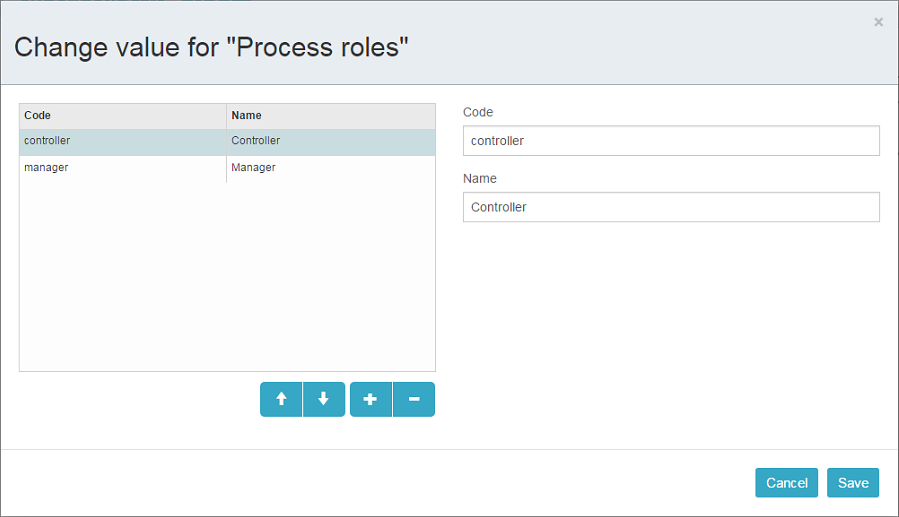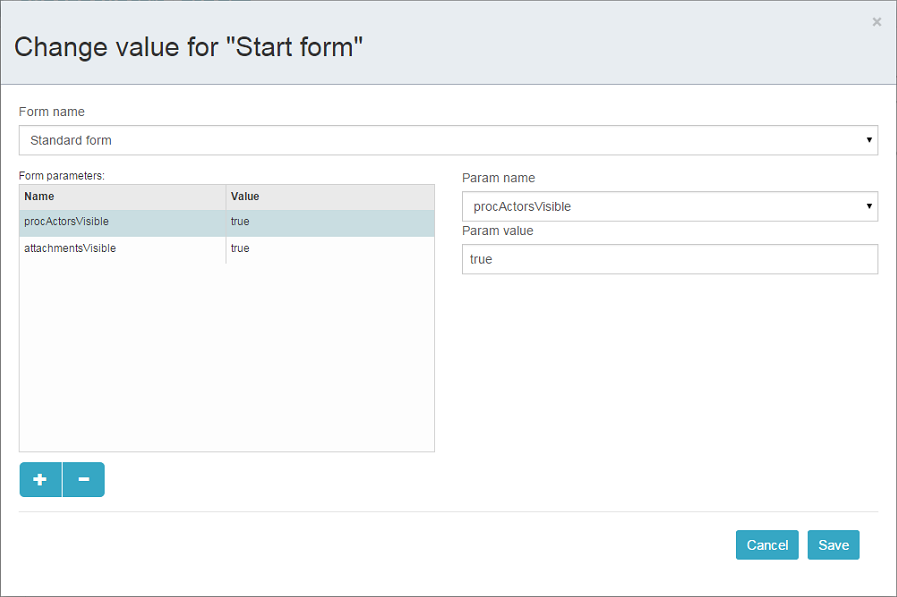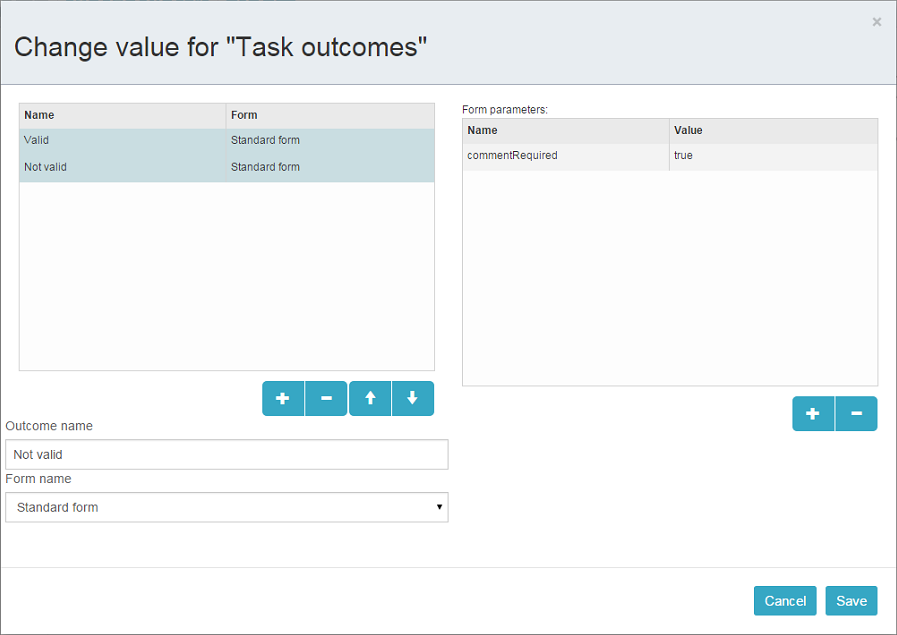1.6.1. Creating the Process model
The final version of the process model will look like this:

Let’s take a look at the steps needed to create the model.
In the web interface of the running application, open the BPM → Process Models screen and click Create. Enter Contract approval for the model name and click OK. Model Editor will be opened in a new browser tab.
|
Tip
|
A notification with a clickable link is shown in case of creating or copying the process model. In case of clicking the Edit button, the process model editor is shown in the new tab. |
Select the Process roles property in the model properties panel. The Process roles edit window will be opened.

Two types of actors participate in the process: a manager and a controller. Create two roles: Controller and Manager.

Drag and drop the Start event node from the Start Events group to the workspace.
We need to display a form to select process actors when the process starts. Select the start event node. Select the Start form in its properties panel - a form selection window will appear. Select Standard form in the Form name field. Then add two form parameters:
-
procActorsVisiblewithtruevalue indicates that a table for process actors selection will be displayed on the form. -
attachmentsVisiblewithtruevalue indicates that a table for uploading attachments will be displayed on the form.

Add the User task node from the Activities group to the model. Name it Validation.

Select this node and assign the controller value to the Process role property at the properties panel. This way we define that the task will be assigned to a process actor with the controller role.

Next, select the Task outcomes property. The window for task outcomes edit will be opened. Outcomes define possible user actions when users receive tasks. Create two outcomes: Valid and Not valid. Define the Standard form for both outcomes. Add form parameter commentRequired=true for the Not valid outcome, because we want to make a user add a comment in case of invalid contract.

Depending on the controller’s decision we have to send the contract to managers approval or to finish the process with the Not valid state. The Exclusive gateway node from the Gateways group is used to control the process flow. Add it to the workspace and then add two more elements: Script task with Set 'Not valid' state name and User task with Approval name. Name the flow to the Script task as Not valid and the flow to the User task as Valid.

Select the Not valid flow. Expand the Flow outcome dropdown list from the properties panel. It shows outcomes from the tasks before the gateway. Select the Not valid value.

Now, if the Not valid outcome is selected, a transition to this flow will be performed.
The Valid flow should be marked as the default flow (if no other flows condition is true). Select the Valid flow and tick the Default flow property.
|
Warning
|
There must be no value selected in the Flow outcome dropdown list for the flow marked as default. |
Next, select the Exclusive gateway and open its Flow order property editor. Make sure that the Not valid flow is on the first place in the list. Change the flows sequence if necessary.

Let’s move on to the Set 'Not valid' state node. We need to set the state property of the Contract entity to the Not valid value. Select the node. Set the Script format property value to groovy. Click on the Script property field - the script editor will be opened. Copy and paste the following code there:
def em = persistence.getEntityManager()
def contract = em.find(com.company.bpmdemo.entity.Contract.class, entityId)
contract.setState('Not valid')You can use process variables and persistence and metadata platform objects (see Developer’s Manual) in scripts. The entityId variable is created on process start and stores an identifier of the linked entity.
After the contract state is changed, the process should be finished. Let’s add the End event node from the End events group to the workspace and connect the node with the Set 'Not valid' state.
Let’s go back to the Approval task. Define the manager process role for it like we did for the first task. In order for the task to be assigned to many managers simultaneously, set its Multi-instance type property to Parallel.

Create two task outcomes: Approve and Reject (Task outcomes property). For both outcomes, set the Standard form form and set commentRequired parameter to true for the Reject outcome.
After the approval is completed, either Approved or Not approved status should be assigned to the contract depending on the approval result. Add an Exclusive gateway node after the Approval task. Add two Service task after the exclusive gateway: Set 'Approved' state and Set 'Not approved' state. They will do the same thing as the Script task we have added earlier, but in a different way: by invoking a Spring bean method. Name the flow to the Set 'Approved' state as Approved, and the flow to the Set 'Not approved' state as Not approved.

Select the Not approved flow node and select the Reject value in the Flow outcome list. Now if at least one of the managers performs the Reject action then this outcome will be initiated. Select the Approved flow node and check the Default flow checkbox. This means that if no other flow is initiated then this flow will be used.
Set the flow order for Exclusive gateway like we did for the previous one. Select Exclusive gateway and open the Flow order property editor. Not approved should be processed first.

Let’s go back to the Service task. Select the Set 'Approved' state node and set its Expression property to the following value:
${demo_ApprovalHelper.updateState(entityId, 'Approved')}Apply the following script for the Set 'Not approved' state:
${demo_ApprovalHelper.updateState(entityId, 'Not approved')}The Activiti engine is integrated with the Spring framework, so we can access Spring managed beans by their names. entityId is a process variable that stores an identifier of the contract which is linked to the process. Its value is set on the process start.
Connect both service tasks with the End event and click the save button. The model is ready and we can move on to the model deployment.
